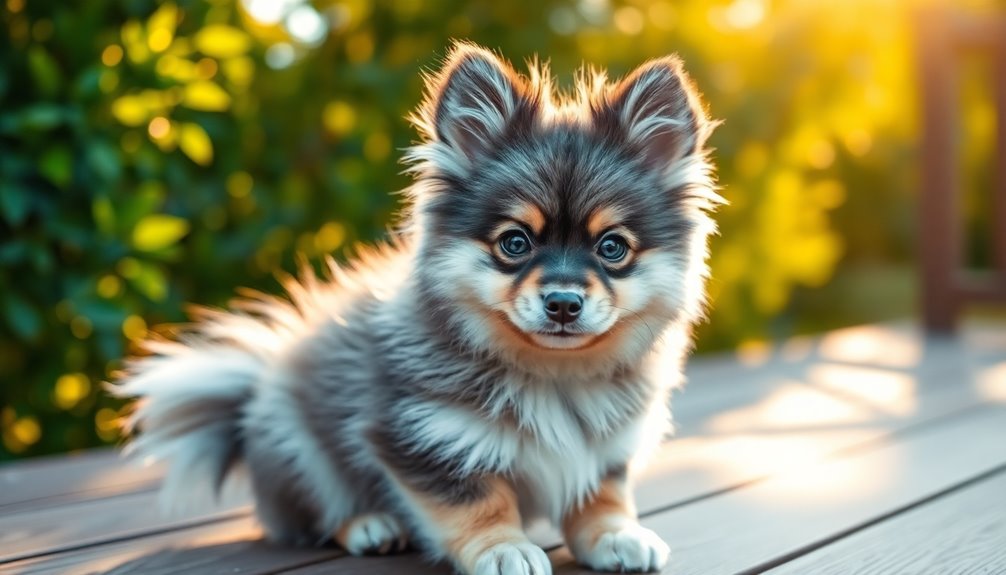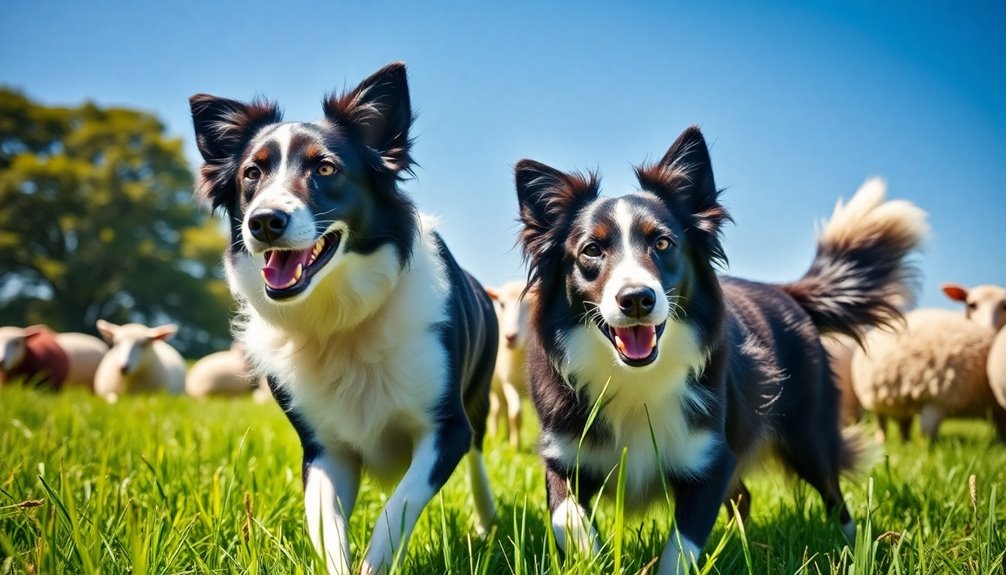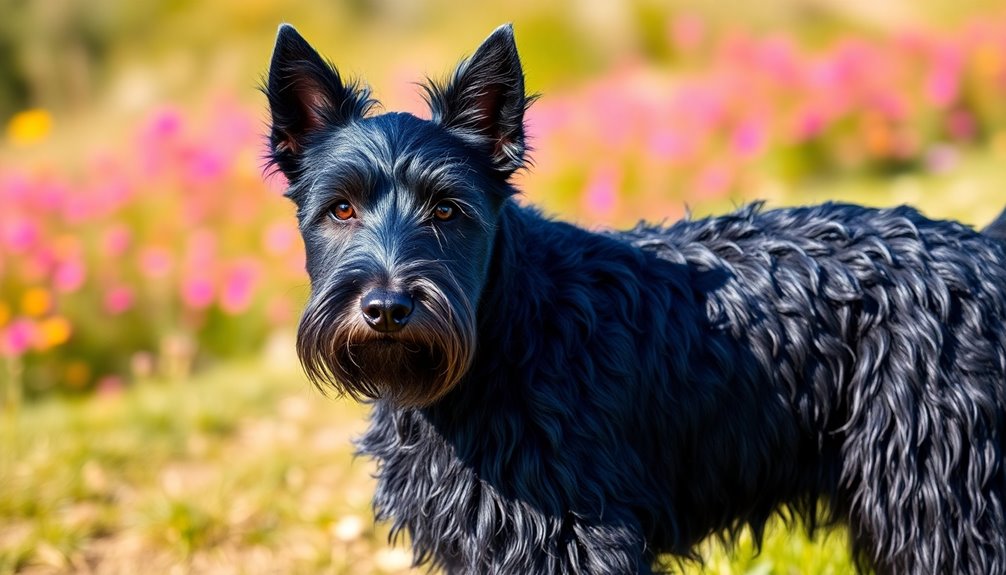If you're curious about Pomskies, you're not alone; this designer breed—a mix of Pomeranian and Husky—is taking the world by storm. With their compact size and striking facial markings, they're incredibly appealing. You'll find their energy and intelligence make them affectionate companions, needing about 1-2 hours of exercise daily. However, they require early socialization and training to manage their vocal tendencies. While they bring joy, be mindful of potential health concerns, like allergies and hip dysplasia. Stick around to uncover more about their unique characteristics and how to care for these charming pups.
Key Takeaways
- Pomskies are a designer breed created by mixing Pomeranians and Huskies, known for their striking appearance and playful personality.
- They typically weigh between 7-38 pounds and stand 10-15 inches tall, making them a compact and appealing companion.
- Pomskies require 1-2 hours of daily exercise and thrive in social environments, making them ideal for active families.
- Early socialization and positive reinforcement training are essential for managing their energetic and vocal tendencies.
- With a lifespan of 12-15 years, proper care, regular vet check-ups, and a balanced diet are crucial for their health.
Introduction
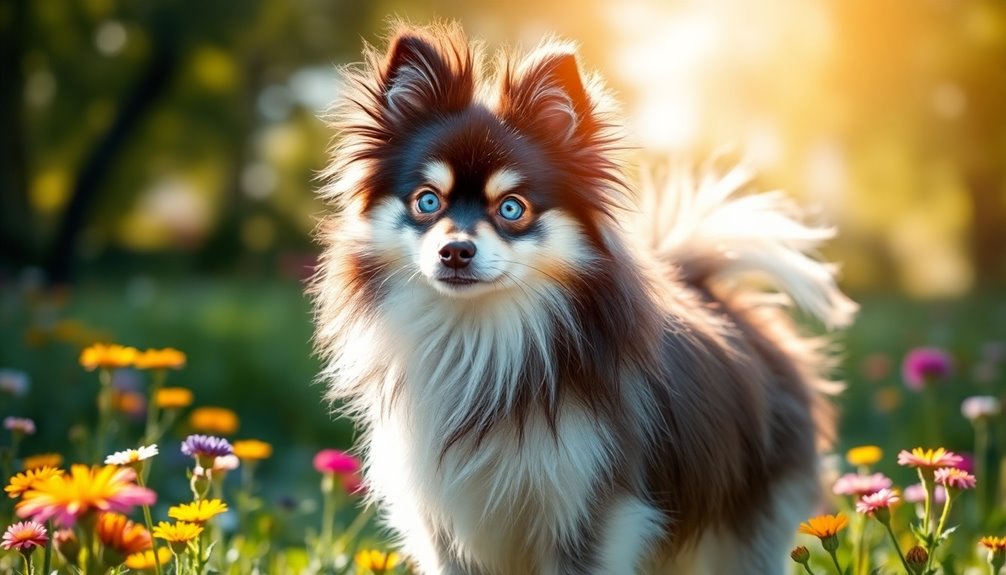
If you've ever seen a fluffy bundle of energy that looks like a cross between a Pomeranian and a Husky, you've likely encountered a Pomsky. This designer breed typically stands between 10 to 15 inches tall at the shoulder and weighs anywhere from 7 to 38 pounds, with most falling between 12 to 35 pounds.
Their compact, athletic build gives them a sturdy appearance, while their double-layered coat adds to their irresistibly fluffy look. You'll often notice their high, curled tail, thickly furred, sitting proudly over their back.
Pomskies come in various sizes: Toy, Mini, and Standard, each with distinct weight and height parameters. Their wedge-shaped heads and expressive faces can resemble both foxes and wolves, and their ears may inherit the Pomeranian's perkiness or take after the Husky's larger size. Their eyes can be a stunning mix of colors, including brown, blue, and amber.
With high energy levels and a playful demeanor, Pomskies are affectionate and intelligent companions. They bond closely with their families, showcasing a protective nature without being aggressive. These dogs require daily exercise to channel their energy effectively, making regular walks and playtime essential for their well-being.
They're lively, curious dogs that thrive on interaction and play.
History and Origin
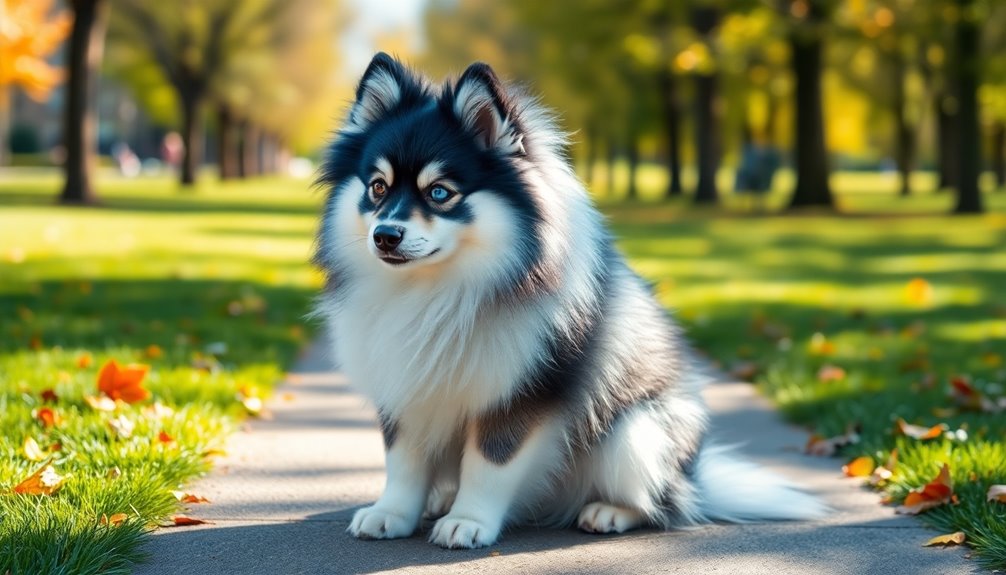
The Pomsky's history begins in the United States, where the first breeding efforts took place around 2009. Initially inspired by the need for sled-pulling capabilities and companionship, this designer breed quickly captured the hearts of dog lovers. As you explore the origins of the Pomsky, you'll see how its unique lineage reflects a blend of functionality and affection. The first documented breeding of Pomskies occurred around 2009 in the United States, laying the foundation for this increasingly popular breed.
Where and when the breed originated
Pomskies burst onto the scene around 2009 in the United States, though their exact origins remain uncertain. The first documented breeding of this unique designer breed likely took place in that year, capturing the imagination of dog lovers.
By the early 2010s, the concept of mixing Pomeranians with Siberian Huskies gained traction, leading to the first intentional Pomsky litter created on March 5, 2012, by Tressa Peterson and Joline Phillips in Arizona. Using artificial insemination, they produced this adorable hybrid.
The breed began to gain significant popularity around 2014, as more breeders worldwide incorporated Pomskies into their programs. In just a couple of years, the number of legitimate breeders in the U.S. surged from almost none to over 30. The popularity surged after a 2011 BuzzFeed article featured the breed, showcasing their unique charm and captivating appearance.
This spike in demand, however, also led to scams and unethical breeding practices, prompting the need for tighter regulations. To combat this, legitimate breeders established strict guidelines, including DNA test reports.
As Pomskies gained traction, organizations like the American Pomsky Kennel Club (APKC) emerged to standardize breeding practices and aim for AKC recognition, solidifying the breed's presence in the canine world.
Sled Pulling and Companionship
Exploring the rich heritage of sled pulling and companionship reveals how Pomskies inherit remarkable traits from their parent breeds. Siberian Huskies were historically bred for sled pulling, excelling in endurance and teamwork. Their ability to pull heavy loads over long distances in harsh conditions set a standard for desirable sleddogs. Interestingly, Huskies played a crucial role during the 1925 diphtheria epidemic in Nome, Alaska, which showcased their strength and loyalty.
While Pomskies don't possess the strength to pull sleds like their Husky ancestors, they do inherit an energetic spirit that keeps them active and engaged. Despite their smaller size, Pomskies thrive in alternative activities. They can excel in agility courses and dog dancing, showcasing their intelligence and adaptability. Early training is key to harnessing their energy and preventing boredom, as establishing clear rules for children can help manage their behavior effectively.
Companionship is another vital aspect of Pomskies, influenced by both Huskies and Pomeranians. Huskies are known for their affectionate nature and loyalty, traits that Pomskies embrace. They crave interaction and integration into family activities, making them loyal companions.
Pomeranians also contribute to this companionship aspect, being alert and engaging despite their small size. Together, these traits make Pomskies not just spirited pets but also loving, active family members.
Physical Characteristics
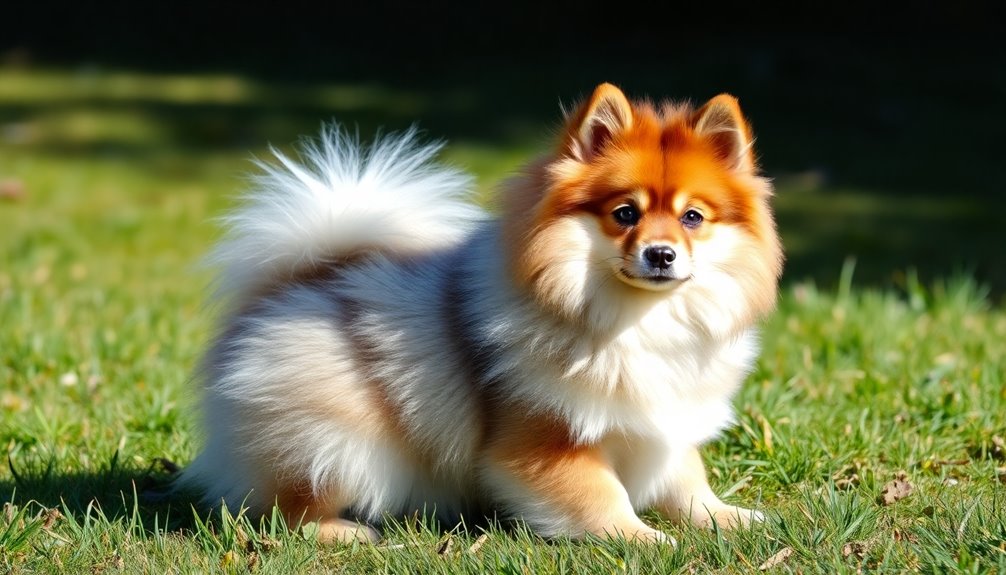
When you look at a Pomsky, you'll notice their compact yet athletic build, typically standing between 10 to 15 inches tall and weighing anywhere from 7 to 38 pounds.
Their coat varies from short to fluffy or even wooly, showcasing a stunning range of colors, including rare blues and lilacs. Some Pomskies may even exhibit exotic colors like blue or lilac, which are highly sought after for their unique appearance.
Plus, their expressive eyes can come in vibrant blue or a mix of colors, adding to their charming appearance.
Size, weight, and coat details
With a range of sizes and weights, the Pomsky is a unique blend that can fit various lifestyles.
You'll find Toy Pomskies standing under 10 inches tall and weighing up to 15 pounds, while Mini Pomskies can reach up to 14 inches and weigh between 12 to 20 pounds.
Standard Pomskies range from 14 to 18 inches tall and can weigh between 20 to 35 pounds.
The weight of Pomskies varies, with general ranges between 5 to 40 pounds. Maintaining an ideal weight is crucial for their health, as regular vet check-ups help monitor their body condition index.
First-generation (F1) Pomskies typically weigh around 15 to 30 pounds, with some as small as 10 pounds or as large as 35 pounds.
Second-generation (F2) Pomskies usually hover around 20 pounds.
In terms of coat, Pomskies sport a double coat that combines the Husky's dense, weather-resistant fur with the fluffiness of the Pomeranian's coat.
Their fur can be thick and plush, featuring diverse colors like black, white, gray, and red.
Many Pomskies inherit the Husky's striking facial markings, giving them an eye-catching appearance that's sure to turn heads wherever you go.
Bright Blue or Multicolored Eyes
One striking feature that captures attention in Pomskies is their eye color, which can range from vivid blue to a captivating mix of hues. All puppies start with blue eyes at birth, but by 3 to 4 weeks, you'll notice changes beginning.
Around 4 to 5 weeks, experienced breeders can estimate if those eyes will stay blue or shift to shades like brown or amber.
Pomskies can exhibit various eye colors, including brown, blue, amber, or even heterochromatic eyes, where one eye differs in color from the other. Blue eyes often remain bright until the puppy finds its new home, while amber eyes may initially seem greenish-blue before turning yellowish.
Genetic factors play a crucial role in these variations, especially with the merle gene from Husky parents, which can lead to unique bi-colored or heterochromatic eyes. Additionally, DNA testing can provide insights into the genetic traits related to eye color and health.
It's essential to know that some eye color changes can continue after you bring your Pomsky home, particularly with amber eyes.
Temperament and Personality
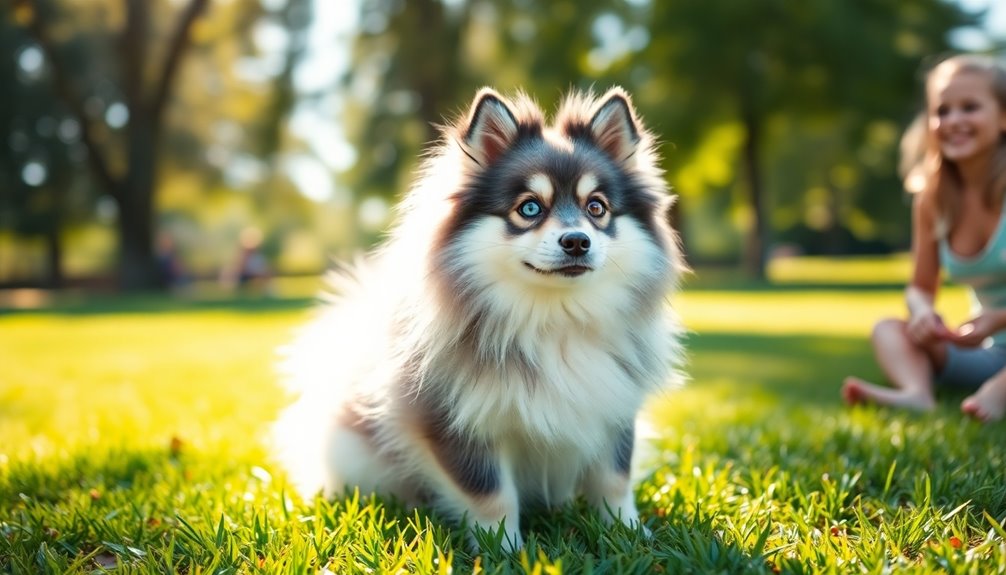
When you welcome a Pomsky into your home, you'll find a playful and social companion who thrives on interaction. These dogs fit well into families, singles, or homes with other pets, forming strong bonds with everyone around them. Their affectionate nature makes them a delightful addition to any lifestyle, provided they receive plenty of attention and playtime. Additionally, their high energy levels require regular exercise and mental stimulation to keep them happy and well-behaved.
Playful and Social Demeanor
Throughout their lives, Pomskies maintain a playful and energetic demeanor that makes them delightful companions. These dogs thrive on activity, so regular walks, playtime, and stimulating activities are essential to keep them engaged. They retain a puppy-like playfulness well into adulthood, combining the lively spirit of the Pomeranian with the energetic nature of the Husky. Additionally, providing them with mental stimulation through training and interactive toys can enhance their playful nature.
Social by nature, Pomskies bond closely with their families and are often described as "velcro dogs." Their affectionate and outgoing personalities make them eager to be around people. While their Pomeranian ancestry contributes to their cheerfulness, the Husky side adds a touch of alertness and mischievousness. They also have a double coat that requires regular grooming to maintain their appearance and health.
You'll find that they're not just playful but also incredibly communicative. Pomskies use a mix of barks, whines, and howls to express themselves, especially when seeking attention. Their alertness and vocal tendencies can be charming, but early training helps manage their vocalizations effectively. Early socialization can significantly improve their ability to interact with other pets and people.
With their intelligence and curiosity, Pomskies require mental stimulation to prevent boredom and mischief. Overall, their playful and social demeanor makes them perfect companions for active individuals or families who can provide the attention and guidance they need.
Suitability for families, individuals, or other pets
Pomskies are incredibly adaptable, making them suitable for a variety of living situations, whether you're a family, an individual, or someone with other pets. Their affectionate nature means they bond closely with you, thriving on attention and companionship.
For families, especially those with older children, Pomskies can be wonderful playmates, provided you can commit to their exercise needs—1-2 hours of daily walks and playtime. It's important to note that Pomskies require ample exercise opportunities to keep their energy levels in check.
If you're an individual, you'll find a Pomsky fits well into your life, especially if you can offer regular social interaction and ample mental stimulation. Keep in mind that they require daily grooming to maintain their fluffy coats and can be quite vocal.
When it comes to other pets, Pomskies need careful socialization. They may do well with compatible breeds like Golden Retrievers or Beagles, but introducing them slowly is key to avoiding territorial issues.
With proper training and attention, Pomskies can integrate into households with various pets. Just remember, these dogs thrive in dynamic environments where they receive the love and interaction they crave.
Health and Lifespan
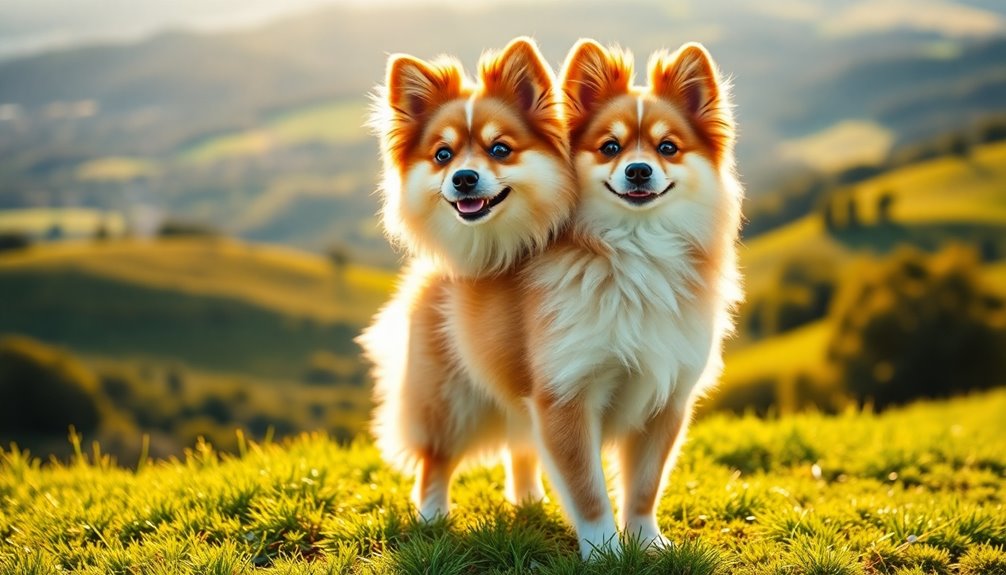
When considering a Pomsky, it's essential to be aware of their typical lifespan, which ranges from 12 to 15 years. They come with some common health concerns, like hip dysplasia and eye defects, that you should monitor closely. To ensure your Pomsky thrives, focus on a balanced diet, regular exercise, and consistent vet check-ups. Additionally, be vigilant about removing genetic abnormalities from bloodlines to promote healthier offspring.
Typical lifespan of the breed
Most Pomskies enjoy a typical lifespan of 12 to 15 years, which aligns closely with their parent breeds, the Siberian Husky and Pomeranian. Your Pomsky's lifespan can vary based on genetics and the care you provide. With proper attention, a healthy Pomsky might even reach the upper end of that range.
Several factors influence their longevity. Genetics play a significant role, but diet and nutrition are crucial too. A balanced diet supports their immune system and energy levels, while avoiding overfeeding helps prevent obesity and related health issues. Additionally, the breed's newness means that lifespan data remains somewhat uncertain.
Regular exercise is essential, so daily walks and playtime should be part of your routine. This not only keeps them fit but also strengthens your bond.
Don't forget about regular veterinary visits; these are vital for early detection of potential health issues. Grooming also contributes to their overall health, ensuring a clean and comfortable coat.
Both male and female Pomskies typically share a similar lifespan, requiring the same level of care and attention. By prioritizing a healthy lifestyle, you'll enhance the quality of life for your Pomsky and maximize their years with you.
Common health concerns or genetic predispositions
Understanding the typical lifespan of a Pomsky is important, but being aware of common health concerns and genetic predispositions is equally vital for ensuring their well-being. This breed can face various health issues inherited from their parent breeds.
Allergies—both environmental and food—are quite common. Hip and elbow dysplasia can cause significant pain, while luxating patella may lead to dislocated knees. Additionally, responsible breeding practices include thorough health testing which can help mitigate some of these inherited issues.
Some specific genetic disorders are also prevalent. Degenerative myelopathy affects about 40% of Pomskies, leading to progressive hind limb weakness. Von Willebrand Type 1 is a blood clotting disorder found in around 10% of the population. Eye disorders, like Canine Multifocal Retinopathy, can result in vision loss.
Joint and skeletal issues, such as degenerative disc disease and bloat, can also pose serious risks. Furthermore, dental problems are common, making regular teeth cleaning essential.
Keep an eye on skin issues like hot spots and allergies that can arise. By being informed about these potential health concerns, you can take proactive steps to help your Pomsky live a happier, healthier life.
Tips for maintaining health and wellness
To keep your Pomsky happy and healthy, it's essential to establish a routine that includes regular veterinary care, a balanced diet, and plenty of exercise.
Schedule annual or bi-annual checkups to monitor their health, focusing on breed-specific screenings for issues like hip dysplasia and dental concerns. Stay updated on vaccinations and preventive treatments for fleas, ticks, and heartworms.
Choose high-quality dog food rich in lean protein and healthy fats while avoiding overfeeding. Consult your vet to determine the right portion sizes and ensure fresh water is available at all times. Managing obesity risk is crucial to prevent conditions like hip dysplasia. Additionally, consider incorporating antioxidants in tea into your routine, as they may support overall health and well-being.
Your Pomsky needs at least 30-60 minutes of exercise daily, incorporating walks and engaging playtime. Activities like fetch or puzzle toys stimulate both their mind and body. Be cautious with excessive jumping to protect their joints.
Regular grooming is also important; brush their coat 2-3 times a week to avoid matting.
Don't forget dental care—brush their teeth at least twice a week and provide dental chews. Following these tips can help ensure your Pomsky thrives for years to come.
Care Requirements
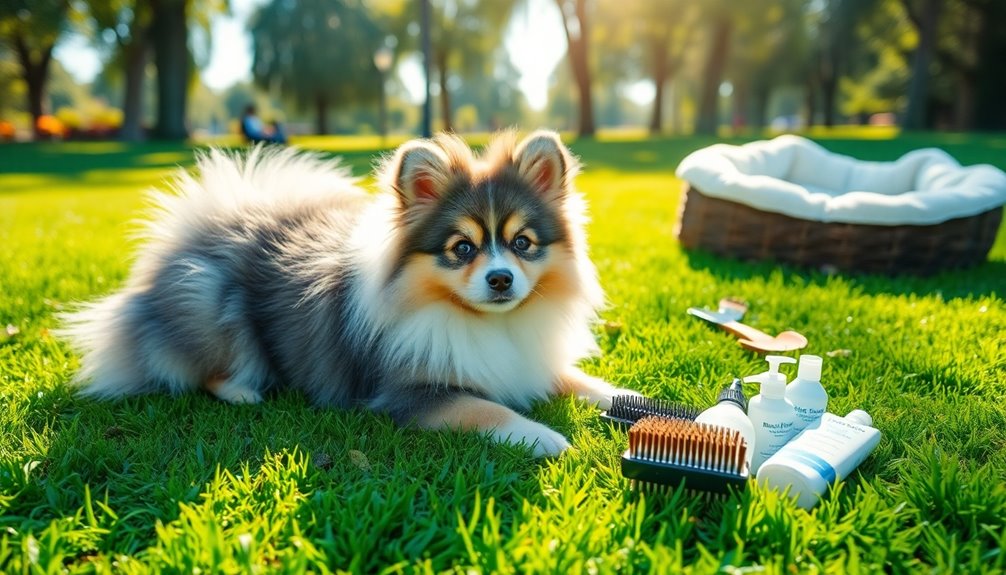
Caring for your Pomsky requires regular brushing to keep their coat healthy and free of tangles. Additionally, it's essential to remember that a thick coat provides insulation against temperature extremes, which is crucial for their comfort. You'll also need to ensure they get plenty of exercise to match their high energy levels. Lastly, focusing on a balanced diet will help maintain their overall health and vitality.
Regular Brushing Required
Keeping your Pomsky's coat in top shape requires regular brushing, ideally 2-3 times a week. During shedding seasons in spring and fall, you'll want to brush daily to manage loose hair effectively. Regular brushing not only helps remove dead hair and prevents tangles, but it also stimulates blood flow, keeping the coat smooth and clean.
For the best results, use a high-quality bristle brush or a slicker brush. An undercoat rake can be particularly effective for tackling that dense fur. Brush gently from back to front, focusing on trouble spots like behind the ears, tail, and upper legs. Avoid furminators or any tool with blades, as they can damage the coat.
Brushing can significantly reduce shedding around your home and helps to prevent matting, maintaining your Pomsky's overall appearance and health. It also distributes natural oils, promoting a healthy shine. Additionally, because of their thick fur, Pomskies may require more frequent grooming compared to lower-maintenance breeds.
Integrating brushing into a broader grooming routine, including bathing and nail trimming, is essential for optimal care. If you start brushing your Pomsky from a young age, it'll make the process much more enjoyable for both of you.
Exercise requirements and energy levels
Maintaining a Pomsky's health goes beyond grooming; it includes meeting their exercise needs. These energetic dogs require at least 45 minutes of exercise each day, but ideally, you should aim for 60 to 75 minutes. Distributing this exercise throughout the day with morning, mid-day, and evening walks keeps your Pomsky engaged and happy. Additionally, caffeine consumption can enhance endurance, making it beneficial for both you and your Pomsky during exercise.
For adult Pomskies, aim for sessions lasting 30 to 60 minutes, while puppies benefit from shorter, more frequent activities to avoid overexertion. Engage your Pomsky with regular walks, hikes, and playtime at the park. High-energy activities like running, swimming, or playing fetch are great options. Consider agility training or running laps in your yard to help burn off excess energy. Additionally, combining mental and physical exercises can promote a well-rounded routine and reduce destructive behaviors.
In unfavorable weather, indoor activities like running up and down stairs or playing fetch can keep them active. Don't forget about mental stimulation; it's just as important as physical exercise. Interactive toys and teaching new tricks can challenge their minds and prevent boredom, reducing destructive behaviors.
If your Pomsky shows reluctance to exercise, start slowly and use positive reinforcement to encourage participation. A well-exercised Pomsky is a happy Pomsky!
Feeding tips and diet recommendations
A well-balanced diet is crucial for your Pomsky's overall health and vitality. Focus on providing high-quality dog food that includes natural ingredients, whole proteins, healthy fats, and complex carbohydrates. Additionally, ensure that your Pomsky's diet is nutrient-rich to support their energy levels and overall well-being.
Aim for a protein content of 22-32% for puppies and 18-25% for adults. Lean meats like chicken, turkey, and beef should be your primary protein sources, while fish such as salmon offers omega-3 fatty acids for coat health.
Don't forget healthy fats, found in fish oil and flaxseed oil, to support energy and skin condition. Incorporate carbohydrates like sweet potatoes, brown rice, and oats for energy and digestion.
Fresh fruits and vegetables, such as carrots and blueberries, are excellent sources of vitamins and minerals. Always provide fresh water to keep your Pomsky hydrated, particularly if they're active or on dry kibble.
Avoid toxic foods like chocolate and grapes, and steer clear of harmful additives in dog food. Be mindful of portion sizes to prevent overfeeding, which can lead to weight gain and health issues.
Lastly, adjust feeding schedules: puppies need 3-4 meals a day, while adults do well with 2 smaller meals.
Training and Socialization
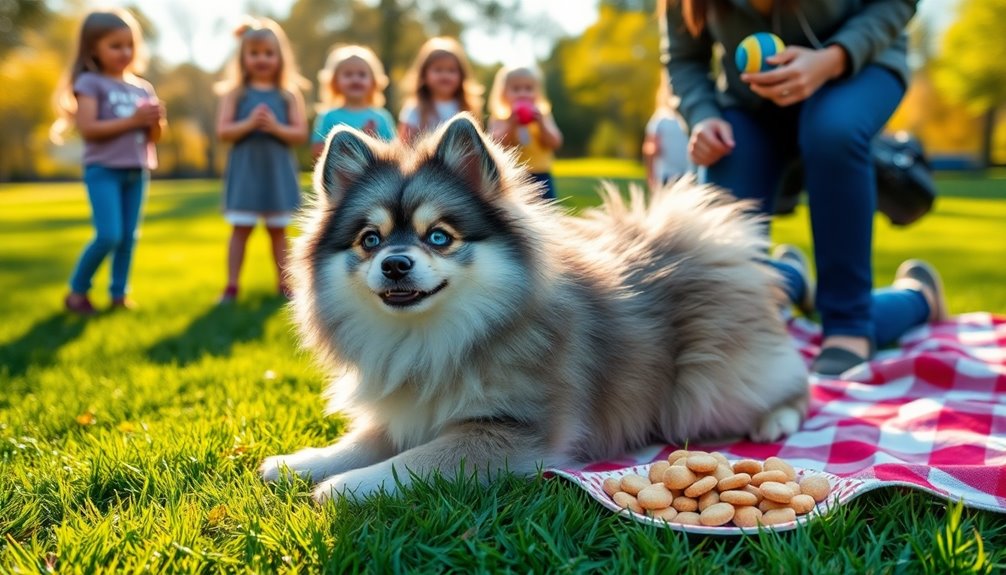
When training your Pomsky, you might notice their moderately stubborn behavior, which can challenge your patience. Gradually introducing them to new environments will help ease their anxiety and promote positive experiences. Additionally, managing leash pulling during walks is crucial to ensure enjoyable outings for both of you. Establishing clear pack leader status can further enhance your training efforts, as it fosters respect and obedience from your Pomsky.
Moderately Stubborn Training Behavior
Though Pomskies are known for their intelligence and playful nature, their moderately stubborn training behavior can present challenges for owners. To effectively manage this stubbornness, you'll want to adopt a training method that resonates with their personality. Positive reinforcement works wonders; rewarding good behavior with treats and praise encourages them to repeat those actions.
Ignore bad behavior rather than punishing it, especially in young Pomskies, to prevent the development of bad habits. For those Pomskies who don't respond well to positive reinforcement alone, consider a balanced training technique. This combines both positive and negative reinforcement—rewarding good behavior while correcting undesirable actions with gentle reprimands.
It's crucial to assert your role as the alpha early on, as Huskies are pack animals. Start training early with basic commands like sit and recall. Keep your Pomsky engaged by gradually introducing advanced commands. Mental stimulation is key; use obedience training as a way to keep their minds busy, as this can also help reduce overall energy levels and prevent undesirable behaviors.
Remember to avoid rewarding high-energy behavior. Instead, wait for calm moments to offer praise, ensuring a more manageable and well-behaved Pomsky.
Gradual Introductions to New Environments
Introducing your Pomsky to new environments can be an exciting yet daunting task, especially since their adaptability varies. Start by familiarizing your Pomsky with surroundings they already know, like your home or backyard. Gradually introduce small changes, such as new toys or blankets, to help them adjust. Play calming music to create a relaxed atmosphere, and reward calm behavior with treats and praise.
Once they're comfortable in familiar spaces, transition to quiet outdoor areas like a less crowded park. Observe their reactions and adjust your approach based on their comfort level. Use familiar toys or games to engage your Pomsky, keeping initial sessions short and rewarding. Regular socialization during this stage is crucial for overall mental and emotional development.
As your Pomsky becomes more confident, expose them to different sounds and surfaces. Begin with low volumes of sounds like car engines and doorbells, and let them explore various textures. Gradually increase the volume and complexity while using positive reinforcement.
When introducing new people or pets, do so slowly, starting with family and friends. Let your Pomsky approach at their own pace, ensuring each new encounter is positive. Supervision is key to making these interactions safe and enjoyable.
Leash Pulling During Walks
As your Pomsky grows more comfortable in new environments, it's time to tackle another important aspect of their training: leash pulling during walks.
Start by acclimating them to the collar and leash. Introduce the collar gradually, letting them wear it for a couple of days before attaching a leash. Allow your Pomsky to walk around the house with the leash dragging for 10-20 minutes.
Practice walking indoors, rewarding them with treats to associate the leash with fun.
To prevent leash pulling, use the "Stop Method": stop walking immediately when they pull, waiting for slack in the leash before rewarding them for returning to your side. It's important to remember that understanding the puppy's behavior is crucial for effective training.
The "Lure Method" can also help; use treats near their nose to keep them close. Remember, avoid pulling on the leash, as it can encourage them to pull back.
Positive reinforcement is key. Reward good behavior with treats, praise, and play. Use a clicker to mark their achievements.
Change pace and direction during walks to keep your Pomsky engaged, and practice stopping periodically to reinforce good behavior.
Stay patient and consistent—mastering loose leash walking takes time!
Ideal Living Environment
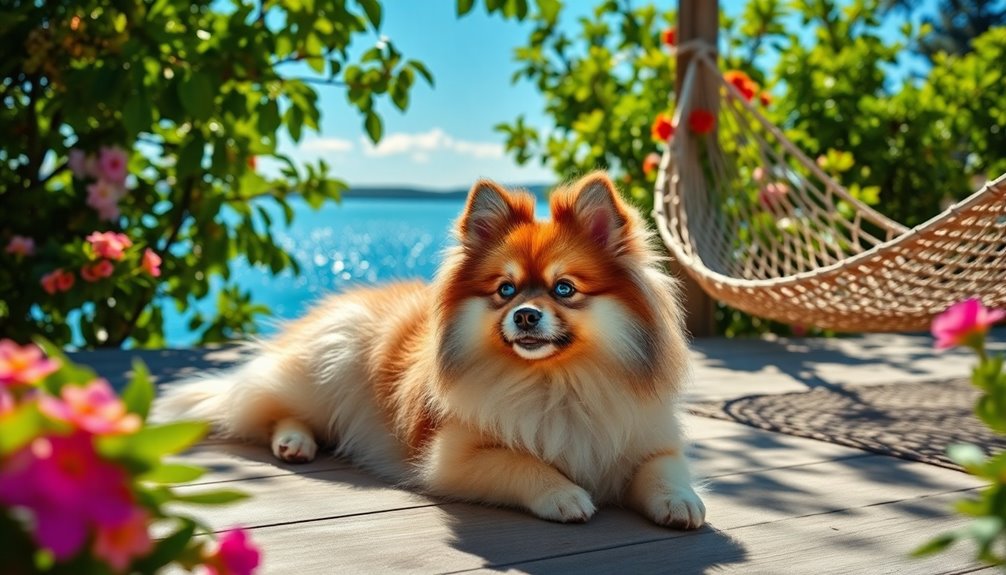
If you're considering a Pomsky, you'll want a house with ample play space to keep them active and happy.
These dogs thrive in colder weather, so having a climate that allows for outdoor exploration in the snow is a big plus. Additionally, because Pomskies are known for their energy and intelligence, providing them with regular mental and physical stimulation is crucial for their overall well-being.
With the right environment, your Pomsky can truly flourish and become a joyful part of your family.
House With Ample Play Space
A house with ample play space is essential for keeping your Pomsky happy and healthy. These energetic dogs require about an hour of daily exercise and play to stay fit and avoid boredom. Regular walks, ideally two or three times a day, are crucial, along with opportunities for them to burn off energy at a dog park. A fenced-in yard can be a fantastic asset, providing a safe area for your Pomsky to romp around.
While Pomskies can thrive in various living environments, including apartments, they still need enough space to move, play, and exercise within your home. Indoor activities like puzzle toys and games can help prevent boredom-induced behavior problems, which are common in these playful pups. Additionally, maintaining a balanced diet is essential to support their energy levels during playtime. Furthermore, regular outings to puppy training classes can enhance their social skills and adaptability.
If you have children or other pets, a Pomsky can adapt well with proper training and introductions. Just remember, they do shed quite a bit, so be prepared for regular cleaning.
A house with ample play space not only satisfies their physical needs but also enhances their mental well-being, ensuring you have a happy, healthy companion by your side.
Cold Weather Enthusiasts
Pomskies thrive in cold weather, making them perfect companions for those living in chillier climates. With their thick, double coat, they're well-equipped to handle harsh winter conditions. This coat consists of a fluffy undercoat for insulation and an outer coat that helps regulate their temperature in summer.
You'll need to groom them regularly, especially during shedding periods in spring and fall, to keep their fur manageable. These playful pups love snow! Engage them in activities like digging, fetching, and jumping around outside. Short, frequent play sessions are best to keep them safe from frostbite.
On walks, sunlight is beneficial for both warmth and vitamin D, but don't forget to protect their paws from dryness. Applying natural balms and trimming fur around the pads can help prevent cracking. Additionally, their energetic nature means they will appreciate ample opportunities for exercise even in colder weather.
Keep your environment safe by removing potential hazards hidden under the snow, like garbage or animal droppings. Also, be cautious with heat sources at home to avoid burns. With the right care, your Pomsky will enjoy a healthy, happy life in cold weather, providing you with a loyal and adventurous companion.
Vocal Howlers and Chatterboxes
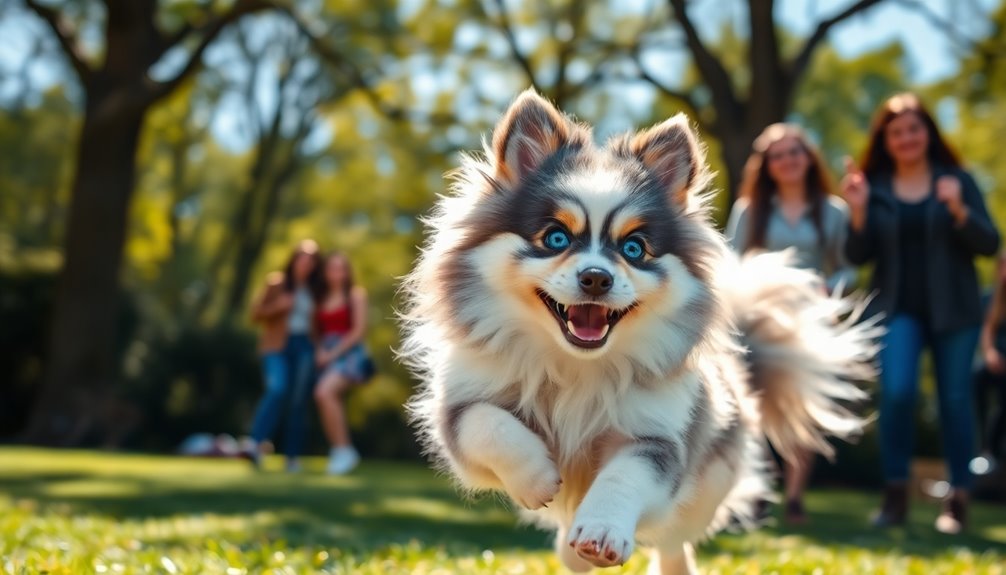
If you're considering a Pomsky, get ready for a mix of vocalizations that'll keep you entertained.
These little chatterboxes not only showcase their playful nature in viral TikTok videos but also come in a hypoallergenic coat variant, making them appealing to a wider audience.
Just be prepared for a lot of barking and howling as they express themselves! Additionally, their intelligent and friendly temperament makes them great companions for families and individuals alike.
Hypoallergenic Coat Variant Exists
Over the years, the Pomsky has gained popularity not just for its adorable appearance but also for its unique coat variations. While no Pomsky is entirely hypoallergenic due to dander production, some have a thinner coat that may be more suitable for allergy sufferers.
These wooly-coated Pomskies shed less than their thick, double-coated counterparts, yet they still require regular grooming to manage shedding and dander. Regular grooming is essential; brushing helps reduce shedding and loose fur, which can minimize allergens and maintain a healthy coat to prevent matting.
Moderate to heavy shedding can lead to increased dander levels, which can trigger allergies in sensitive individuals. Therefore, it's essential to brush your Pomsky regularly—several times a week for wooly coats, a couple of times weekly for plush coats, and at least once a week for standard coats.
Using deshed shampoo and scheduling blow-outs can also help minimize dander production.
If you're considering a Pomsky but have allergies, spend some time with one to see how your body reacts. Regular interaction will help you determine if their coat type works for you.
Ultimately, while some Pomskies may be better suited for allergy sufferers, no coat type guarantees complete hypoallergenicity.
Featured in Viral Tiktok Videos
Captivating audiences on social media, Pomskies have become stars in viral TikTok videos, showcasing their vocal talents and charming personalities. If you've watched these clips, you've likely seen the impressive range of sounds they create, from barks to howls. Some Pomskies are naturally vocal, while others are quieter, reflecting their unique personalities. This variability keeps their fans entertained and engaged.
Often, these adorable pups vocalize to get your attention or to express their needs. When they feel left out or bored, you might hear a series of playful whines or barks, urging you to interact. This expressive communication style, inherited from their Husky and Pomeranian lineage, makes them fascinating companions. Furthermore, their high energy levels mean they thrive in active households, where their playful antics can be fully appreciated.
However, if you live in a quiet environment, you might want to consider their vocal nature. While some owners find their chatterbox tendencies amusing, others may struggle with noise restrictions.
With proper training and engagement, you can manage their vocal behaviors effectively. Whether you love their howls or prefer a quieter companion, Pomskies undoubtedly bring a playful energy that keeps their TikTok audience coming back for more.
Active Lifestyle Compatibility
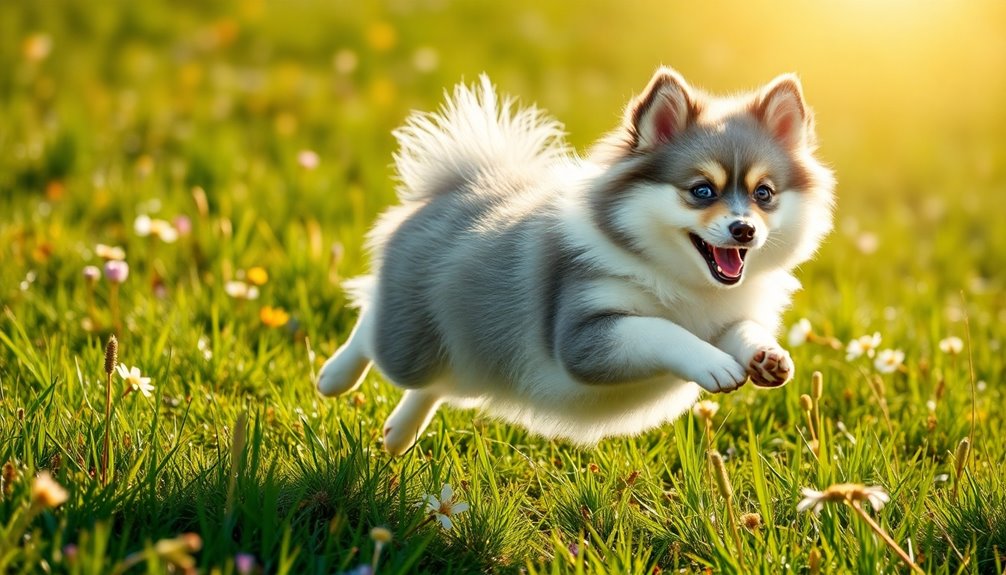
If you lead an active lifestyle, a Pomsky could be the perfect companion for your adventures. These energetic dogs thrive on daily exercise and love to participate in family activities, making them great for active households. Just remember, along with their exercise needs, you'll need to stay on top of their grooming to keep them looking their best. Their high adaptability to various living situations means they can easily adjust to your routine and join in on your outdoor escapades. Additionally, keeping your Pomsky engaged with consistent exercise can significantly enhance their emotional and psychological growth.
Family-Friendly and Active Dogs
Embracing an active lifestyle with a Pomsky can be incredibly rewarding, as these dogs thrive on both physical activity and family interaction. Their affectionate and playful nature makes them excellent family pets, bonding closely with you and your loved ones.
To ensure a harmonious relationship, introduce your Pomsky to children early and teach them to handle the dog gently. Supervised playtime with younger kids is crucial for everyone's safety.
Pomskies are high-energy dogs that need daily exercise to stay happy and healthy. Regular walks, interactive play sessions, and activities like hiking or swimming are essential for burning off their energy. Additionally, their high energy levels mean they enjoy engaging in activities that stimulate both their minds and bodies.
They enjoy exploring new places, making them great companions for outdoor adventures. Engaging them in agility training or DIY obstacle courses also keeps their minds sharp and their bodies fit.
They can adapt to smaller living spaces but thrive when they've access to larger outdoor areas. Consistent training and structure help your Pomsky understand boundaries, ensuring they feel secure in your active household.
Grooming Needs and Maintenance
While keeping your Pomsky active and happy, don't overlook the importance of grooming to maintain their coat and overall health. You should brush your Pomsky 3-4 times a week, or daily during shedding seasons. A slicker brush works great for their outer coat, while a de-shedding tool helps manage the undercoat. Using high-quality tools prevents damage and discomfort, so invest in a bristle brush to smoothen their fur and an undercoat rake for dense areas. Additionally, their double coat provides excellent insulation and temperature regulation, which is essential for their comfort. Regular grooming can also help identify potential skin issues early, such as allergies and irritations, promoting overall well-being.
Bath your Pomsky every 4-6 weeks, or as needed, using a gentle, dog-specific shampoo. Make sure to rinse thoroughly to avoid skin irritation. After bathing, apply a conditioning spray or leave-in conditioner to keep their coat hydrated and healthy.
Trimming around the paws and sanitary areas is essential, but avoid cutting the main body coat to preserve its natural protection. During shedding seasons, use de-shedding tools and brush daily, especially in spring and fall.
Early acclimation to grooming procedures is key; handle their paws and examine their ears from a young age. Consistency in grooming helps maintain their coat health, prevents matting, and provides mental stimulation.
Frequently Asked Questions
What Is the Average Cost of a Pomsky Puppy?
When you're looking to buy a pomsky puppy, expect to pay between $1,500 and $6,000.
The price can vary based on the breeder's reputation, the puppy's size, and unique traits like color and markings. Smaller, more distinctive pomskies usually cost more.
Don't forget to factor in additional expenses like vet care, registration, and potential travel costs.
It's wise to research thoroughly to avoid scams and ensure you're getting a healthy puppy.
Are Pomskies Hypoallergenic or Good for Allergy Sufferers?
Pomskies aren't hypoallergenic, despite common misconceptions.
All dogs produce dander, and Pomskies can shed moderately to heavily, increasing allergen levels.
While some might've less irritating coats, you can't guarantee a hypoallergenic option.
If you have allergies, regular grooming, air purifiers, and a clean environment can help manage dander.
However, living with a Pomsky still might be challenging, so consider your allergies carefully before bringing one into your home.
How Much Exercise Do Pomskies Need Daily?
Pomskies need a solid hour of exercise daily to stay fit and happy. Aim for at least 45 minutes, but 60-75 minutes is even better.
You should incorporate daily walks, running, and playtime at parks to keep them engaged. Mixing physical activities with mental stimulation, like puzzle toys or training new tricks, can also help prevent boredom.
Always watch for signs of exhaustion, and adjust their routine as they age.
Do Pomskies Get Along With Other Pets?
Yes, Pomskies can get along with other pets, especially if you socialize them early.
Introduce your Pomsky gradually to new companions, like dogs or cats, starting on neutral ground. Watch their interactions closely, as individual personalities vary.
They may have a prey drive, so keep an eye on them around smaller animals.
Providing separate spaces for eating and resting can help maintain harmony in your multi-pet household.
What Is the Best Diet for a Pomsky?
To ensure your Pomsky thrives, focus on a balanced diet rich in high-quality proteins like chicken or fish, aiming for 22-32% protein for puppies and 18-25% for adults.
Include healthy fats for energy and coat health, and opt for whole grains like brown rice for sustained energy.
Don't forget essential vitamins and minerals, and always provide fresh water.
Avoid fillers to keep their digestive system healthy and happy.
Conclusion
In conclusion, the Pomsky's charm and playful nature make it an irresistible companion for many dog lovers. With their striking looks and lively personality, these designer pups thrive in active households that can meet their exercise needs. Remember to prioritize training and socialization to help them become well-adjusted pets. If you're ready for a fun, furry friend to brighten your life, the Pomsky just might be the perfect fit for you.

